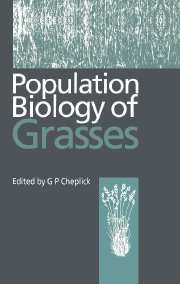Darwin revisited: approaches to the ecological study of grasses
Published online by Cambridge University Press: 14 September 2009
Summary
At the beginning of a book on the ecological behaviour of an important and distinctive family of plants, it is not an entirely stupid thing to contemplate and analyse what we are doing – not so much what we are trying to do as how we are trying to do it. It is possible that by such an exercise we can obtain a clearer idea of the approaches most likely to yield valuable results.
This book is about the many different properties of grass populations and species, and the differences between them. But why should such a collection of studies be put together? What value can come from it? Grasses are, of course, interesting to many people for their own sake. But they also occupy a greater area of the world's land surface than any other plant family. As both food for grazing animals, and as grain crops, the grass family provides more of our food than any other family. Unlike many other families, grasses are found in almost every environment.
A common background
But at the same time grasses have a consistent, almost curious morphology and internal structure – in particular, the leaves and the division of the stem into nodes and internodes – which give both a considerable uniformity to the whole family and a series of special properties. With the nodal structure is associated an ability to produce both roots and shoots (either aboveground tillers or underground rhizomes) freely. Anyone who wishes to understand more about the uniqueness of the Gramineae should consult the remarkable book by Arber (1934).
The ability to produce shoots means that the grasses have considerable abilities to grow and propagate themselves vegetatively.
- Type
- Chapter
- Information
- Population Biology of Grasses , pp. 1 - 8Publisher: Cambridge University PressPrint publication year: 1998
- 2
- Cited by

